Visit to Andes villages in Boyaca gives insight into Colombia then and now
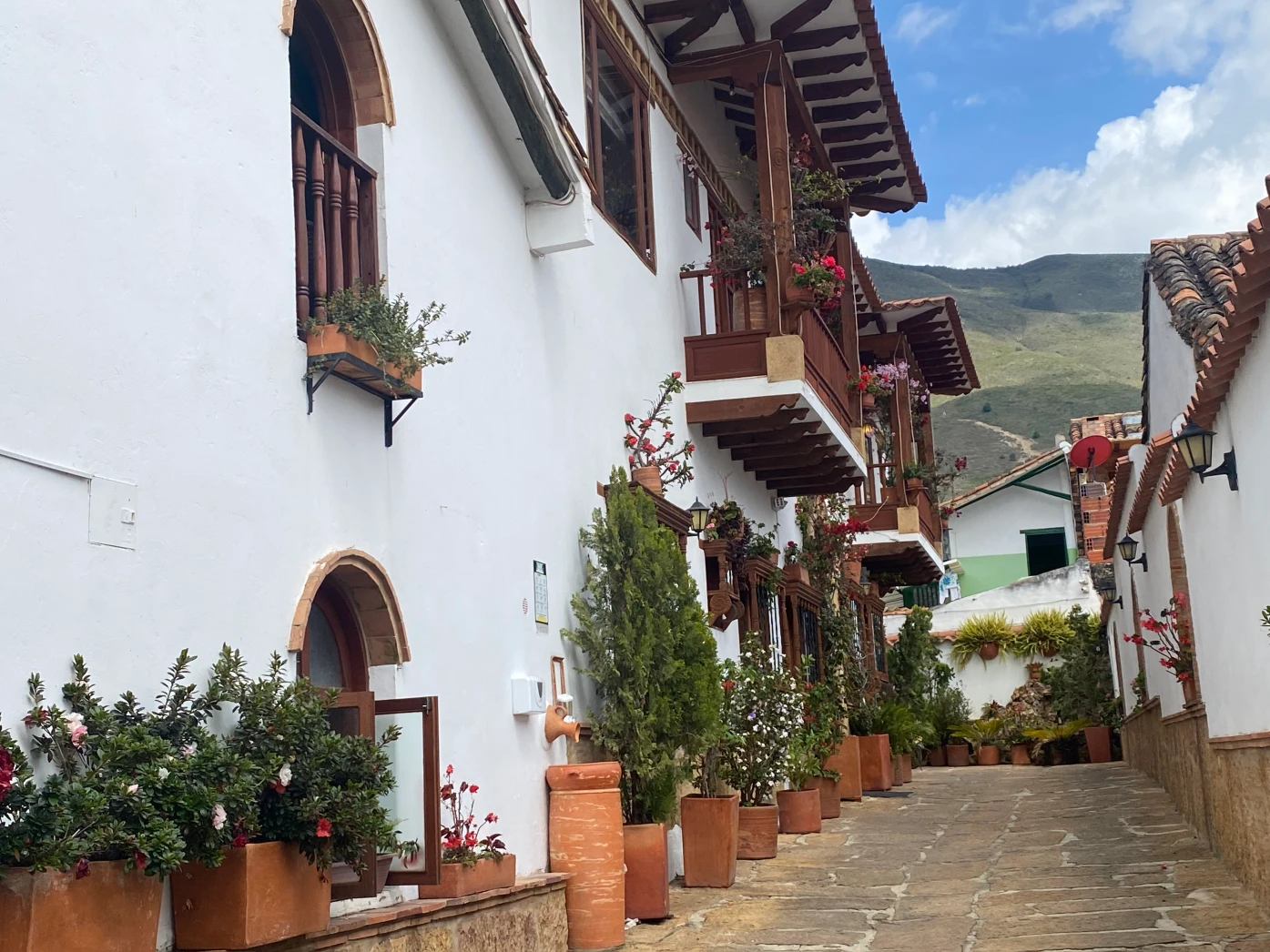
Little changed in hundreds of years, the sunny, white-washed Villa de Leyva makes a good headquarters for visits to Andes villages in the surrounding Boyaca countryside north of Bogota. (Janet Podolak)
With only a few free days in Colombia before my September conference in Bogota, I wanted to spend time among the locals. This South American country twice the size of Texas includes every climate possible, but temperatures are spring-like in Bogota year-round. So I chose an organized driving tour to Boyaca in the Andes a few hours north to learn about Colombian ways of cooking, hat making and creating pottery from local resources.
Our 4-wheel drive vehicle took eight of us along winding mountain roads robed with colorful wildflowers to villages at 10,000 feet, well above the breathless 8,800-foot altitude of Bogota. (See Bogota, Colombia’s capital: closer, cooler and more interesting than you’d think)
A good place to headquarter for a Boyaca visit is the sunny town of Villa de Leyva, in a high mountain valley at about 7,500 feet. Little changed since the 1500s, the whitewashed village is surrounded by trails ideal for outdoors fun. Prices in its high season, Dec. 20 to Jan. 15, escalate, but places to stay and eat abound. They range from boutique hotels in an 1860s home to guest houses with communal kitchens.
It’s best to go with a guide when hiking the steep mountain paths to reach waterfalls with pools for swimming, but tour operators, bike rentals and horseback excursions can be found around Villa de Leyva’s Plaza Mayor, one of the largest town squares in South America.
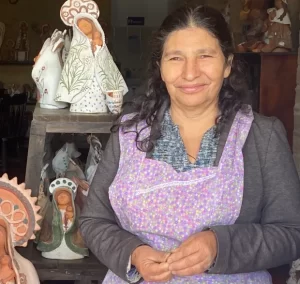
Requira’s local clay, better known for its pots, is used by Rosa Maria Jerez to create Madonnas, which she sells. She gives visitors a first-hand experience with the clay, which she prepares with her bare feet. (Janet Podolak)
Just 15 miles southwest is Raquira, the pottery capital of Colombia, where stacks of freshly fired clay pots and creations such as piggy banks are arrayed in workshops where you can watch them being made.
Rosa Maria Jerez was discouraged by her mother when she began to create likenesses of the Madonna with the local clay.
“She wanted me to make bowls like everyone else in Raquira,” she told us through our guide, Yohan Bayona, who translated.
We were invited into her studio to see how she prepares the clay and then handcrafts it into the lovely figures sold in her shop.
Using her bare feet to massage the clay to the consistency needed, she recruited helpers from our small group. Soon we were removing our shoes to stomp in the clay, before sitting down at a table where lumps of clay were placed in front of us so we could try it ourselves. Some of us were more successful than others.
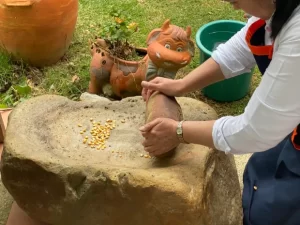
Dried corn is ground between stones to demonstrate how early Colombians made their food during an outdoor cooking class at a mountainside home. (Janet Podolak)
At a pretty mountainside home near the 300-person village of Gachantivá, we were led among chickens grazing in the lush grass to a tin-roofed outbuilding with a freestanding wood-fired oven plastered in white.

Tour group member Ryan Shauers kneads a corn-based dough that will be cut into cookies. (Janet Podolak)
“Grinding corn was originally a job for indigenous people,” our blue-aproned hostess told us as she knelt at the edge of a large stone with dried corn kernels on its concave surface.
We each took a turn, crushing corn kernels into a meal-like consistency with a larger stone.
“Today we use a hand grinder,” she said as she left our ground corn for the chickens and assembled the sugar, egg, and honey ingredients for us to mix corn-based cookies. After baking the shortbread-like cookies in the outdoor oven, we were treated to a snack and given bags of cookies to take with us.
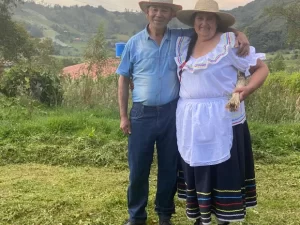
Orlando and Alba Marchan pose outside their home, where he grows unusual albino berries and she hand-weaves hats. (Janet Podolak)
Then it was back in the van for a drive to meet Orlando and Alba Marchan at their small farm, where Orlando grows rare white albino blackberries and his wife gathers and weaves endemic and protected palmicho leaves into hats.
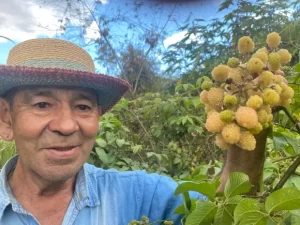
Orlando Marchan wears a hat made by his wife as he shows off the albino berries he grows. (Janet Podolak)
Orlando led us to see his berry bushes and encouraged us to pick a few to taste. Several thorny bushes had dark blackberries, so we were able to taste them, too. Both were delicious, but the white ones tasted more unusual.
Back at the house, Alba was at work braiding tiny strands of palmicho to make into a hat.
The palm leaves must cure with low heat, then be washed and hung flat to dry before they can be used. It takes eight days to prepare the palmicho for braiding, Alba told us through our translator.
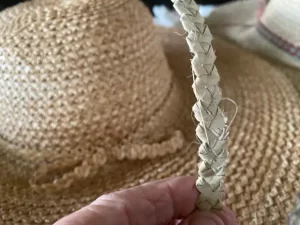
Palmicho leaves, endemic in Colombia, are dried, cured and braided into fine strands by Alba Marchan to craft into hats, each of which takes 20 days to make. (Janet Podolak)
“It takes 20 days to make a hat,” she said.
In 2011, Alba Marchan was invited to demonstrate her hat-making prowess at the Smithsonian Folklife Festival in Washington, D.C. Later, when we examined the quality of hats sold on the streets of Bogota, we were even more impressed with her fine work.
All too soon we were back in Bogota to discover an entirely different way the local clay is used. It’s part of the targets at Tejo La Embajada, where hockey puck-like metal discs are tossed by players to be imbed in clay where gunpowder explodes when the target is hit. Not unlike cornhole, it’s the national sport in Colombia.
When the court was vacated, an attendant came to smooth out the clay. Beer and food is part of the experience for groups of six to eight, and, like bowling, leagues abound.
Nearby is Bogota’s Gold Museum, with 34,000 pieces of gold crafted long ago by Colombia’s indigenous people, who believed gold was earth’s sacred manifestation of the sun. Gold breastplates, headpieces and other creations, worn in rituals by the ancient Muisca people, were given back to earth as sacrifices by dumping them into the middle of Guatavita Lake, to the north.
Many of those pieces today are among collections in the Gold Museum, which interprets the discoveries in both English and Spanish for museum visitors.
After witnessing the rituals, Spanish conquerors of the 1500s believed there were vast quantities of gold hidden by the natives. Legends of El Dorado and the search for that mythical gold drew explorers from afar such as Sir Walter Raleigh to search in Colombia, Venezuela and Brazil.
Choices abound in this huge South American country, but I didn’t want to fly to the Caribbean or the Pacific coasts, the fertile western coffee country or its Amazon regions. Boyaca, two to three hours north of Bogota by car, is where Colombia won its freedom from Spain in 1810 so the area inspires a sense of patriotism among its countrymen.
My tour was organized by Green Travel. Email info@colombiagreentravel.com.
My English-speaking and very well-informed guide, Yohan Bayona, can be contracted for tours. Reach him at yybayona@hotmail.com.
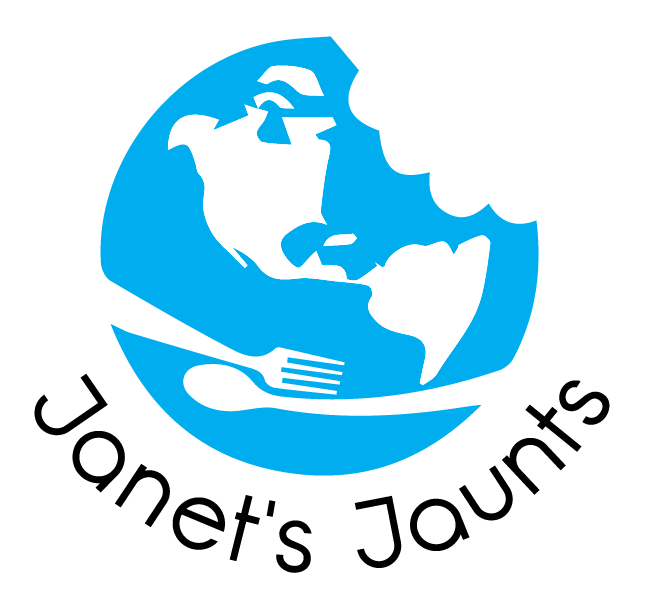

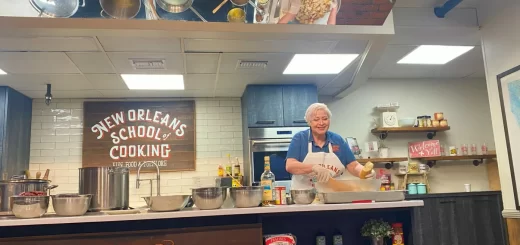
Recent Comments